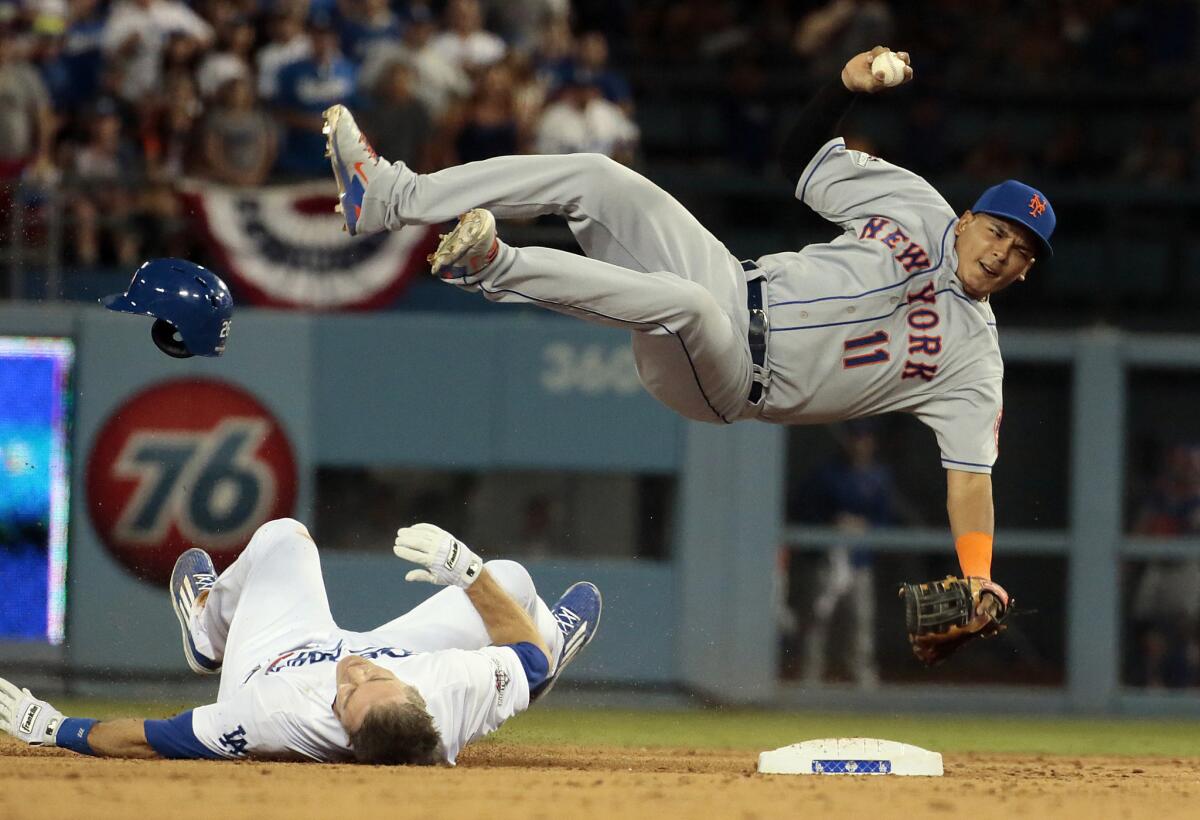The post-Chase Utley era: The new MLB rules for slides into second base

Dodgers’ Chase Utley upends the New York Mets’ Ruben Tejada to break up a double play during Game 2 of the teams’ National League Division Series.
- Share via
For decades, baseball reveled in a semi-orchestrated ballet at second base, where an infielder would try to jump above a runner determined to knock him down and prevent him from completing a double play.
The highlight reels celebrated that grace. They also showed the brute force of a runner charging like a bull into home plate, trying to dislodge the ball from a catcher’s mitt.
For the second time in three years, tradition has yielded to safety.
On Thursday, two years after outlawing collisions at home plate, Major League Baseball banned runners sliding into second base from kicking, shoving or throwing their bodies into an oncoming infielder.
No matter how deeply those plays might have been ingrained in the fabric of the sport, the risk of serious injury always loomed.
“I think that will definitely help keep guys healthy, for sure,” Dodgers infielder Chase Utley said.
The new rule is destined to be known unofficially as the Utley Rule, much as the restriction against collisions at home plate is known as the Buster Posey Rule.
The Utley Rule took effect four months after he rolled into an airborne Ruben Tejada during the playoffs at Dodger Stadium; the New York Mets shortstop hit the ground hard, suffered a broken leg and could not compete in the World Series.
The Posey Rule took effect three years after the San Francisco Giants’ star catcher — and 2012 National League most valuable player — lost four months to a broken leg.
The league clearly has decided that keeping its stars — players getting paid ever-increasing millions of dollars — on the field is an urgent priority. In the case of the home-plate rule, reform has been a success: No catcher has been significantly injured in a home-plate collision in the two years since the introduction of the Posey Rule.
Neither the Posey play nor the Utley play was unique. Such plays were common, in fact, in a sport that has long celebrated sacrificing one’s body for the greater good of the team.
But Posey’s injury put the face of one of baseball’s most talented players on the question of why the sport would not legislate a common-sense solution to keep its stars healthy. Utley’s slide — and Tejada’s injury — occurred under the bright lights of a postseason game between teams representing the two largest cities in America.
League officials insisted they had for some time been considering how to make plays at second base safer and it wasn’t related to Utley’s slide.
“From my understanding, I think we’ve been trying to work on this for a few years now, trying to get on the same page,” Utley said. “Now, obviously, we are. I don’t think one instance really determined anything.”
Utley was suspended for two games and his appeal is expected to be heard next month. After Joe Torre, chief baseball officer and former Dodgers manager, announced the suspension in October, he said Utley had slid late, “more targeting the player as opposed to the base.”
Nonetheless, how Utley broke up that double play — cited by Torre as a “rolling block” — is now explicitly banned. Players sliding into second base must make “a bona fide attempt to reach and remain on the base,” without kicking a leg or throwing an arm or shoulder into a fielder, and without veering away from the base and toward a fielder. A player sliding straight into second base still can make contact with the fielder.
A violation of the rule will result in an automatic double play. The play is subject to replay review.
“Our goal in amending the slide rule was to enhance player safety, reduce incidents of injury and to do it in a way that respects and preserves the bona fide hustle plays that are integral to our game,” said Tony Clark, executive director of the Major League Baseball Players Assn. “I am optimistic that this new rule will accomplish those goals.”
Another wrinkle is how the change will interact with one of baseball’s unwritten rules. For years, infielders have been forgiven for not touching second base on a double play so long as they came close. That so-called “neighborhood play” was designed to protect infielders from an aggressive baserunner.
Now, with much of that aggression legislated out under the rule announced Thursday, infielders will be expected to touch second base on a double play, even with a runner sliding into the base.
“We’re going to have to see how it all plays out,” Utley said. “With the home-plate rule, it took a little time for players and umpires to understand what really works. I imagine the same will happen here.”
Twitter: @BillShaikin
Times staff writer Andy McCulllough contributed from Phoenix to this report.
ALSO
Friedman’s long-term vision vs. Dodgers’ fans win now mentality
Greg Maddux joins Dodgers camp, is ready to give advice to those who seek it
Reduction in spring telecasts is just the latest outrage in Dodgers’ ongoing TV boondoggle
More to Read
Are you a true-blue fan?
Get our Dodgers Dugout newsletter for insights, news and much more.
You may occasionally receive promotional content from the Los Angeles Times.








